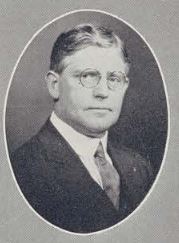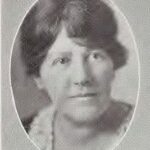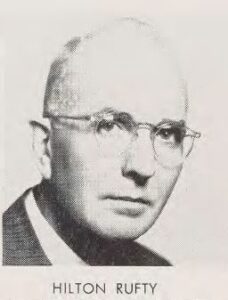1914-20

F. Flaxington Harker (The Web, 1927)
In the earliest years on the Westhampton campus, music ensembles were directed by faculty from a variety of departments: Eugene C. Bingham (Chemistry) led the Mandolin Club, and J.M.D. Olmsted (Biology) was director of the Richmond College Glee Club. H. H. Seay (Economics) also led the Mandolin Club, as well as the College Orchestra, which was actually a dance band with constantly changing instrumentation. This arrangement was due, in part, to a lack of funds to hire trained music faculty. In 1916 the Scottish-born organist and composer F. Flaxington Harker (1876-1936) became the University’s first Director of Music, teaching piano and leading both the Richmond College Glee Club and the co-ed Vesper Choir. His wife, Edith Clarke Harker (1875-1952), taught piano and voice, and co-hosted Saturday afternoon musicales in the Blue Room of Westhampton Hall. Additionally, a few local music teachers were authorized to give instrumental lessons to Westhampton students.
1921-30

Edith Clarke Harker (The Web, 1929)
Mrs. Harker became director of the Westhampton Glee Club in 1922, a post that she would hold until 1945. Responding to student demand, in 1925 Mr. Harker began teaching music appreciation classes at Westhampton, while local music educator Edward Naff took over the Richmond College Glee Club, and supervised the formation of two orchestras. Naff was also music director at radio station WRVA, which likely facilitated both Glee Clubs’ first on-air performances in 1926. When Naff’s radio work became too time-consuming, Mr. Harker returned to lead the RC Glee Club.
1931-40
Responding to a campaign by student musicians and Omicron Delta Kappa, in 1938 the University hired William T. Sinclair (1904-1968), a public school music teacher, to lead the Richmond College Glee Club and the UR Marching Band. Glee Club became an official class, and the band grew in size and quality until Sinclair departed four years later, citing the demands of his out-of-town business.
1941-50

(The Web, 1956)
Henry Fuchs (1885-1962), a violinist, composer, and conductor, was appointed University Music Director in 1942, after working for the WPA Music Project. He lectured, gave violin lessons, conducted the student orchestra, and occasionally stepped in as band director. Hilton Rufty (1909-1974) joined the faculty in fall 1946, as the new chair of the Music Department. Rufty was a pianist, composer, and carillonneur whose scholarship focused on Anglo-American folksong. He was also a student and admirer of the composer/pianist John Powell, a notorious segregationist.
1951-60
In the 1950s the University hired several new professors who would go on to distinguish themselves in the field of music. In 1953 John White (1925-1984) was hired as chair of the Music Department, and a year later James Erb (1926-2014) arrived to conduct student choral groups. Erb would go on to found the Richmond Symphony Chorus, edit the works of Orlando di Lasso, and create an iconic arrangement of the folksong “Shenandoah.” Two Europeans joined the Music faculty in 1955, the Austrian violinist Frederick (“Fritz”) Neumann (1907-1994) and the English pianist Roy Jesson (1926-1972).
1961-70
The 1960s were a period of transition. In 1961 Roy Jesson returned to his native London to teach at the Royal College of Music, while John White left the University in 1966 to become the director of New York Pro Musica Antiqua. James Erb stepped in to chair the Music Department (but he only earned his Ph.D. in 1971, and became chair upon his return to campus).
1971-80
Music Department alumna Suzanne Kidd Bunting (chair in 1971). Barbara McMurtry 1974. In the fall of 1976, Homer Rudolf joined the faculty as chair of the Music Department.
1981-90
1991-2000
Spring 1994: Erb retires
2000-2014